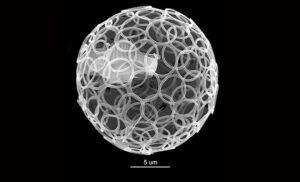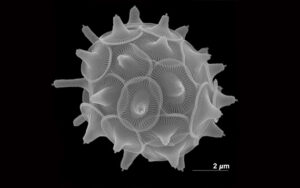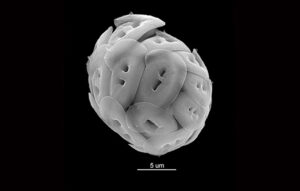A Big Commotion about Bermuda’s Coccolithophores

Samples from waters off Bermuda have revealed an exciting discovery for a team of researchers led by Josué G. Millán, PhD candidate at Indiana State University: 40 new species of undescribed coccolithophores, a type of phytoplankton. BIOS zooplankton ecologist Leocadio Blanco-Bercial, who was also involved with the project, says the Sargasso Sea is “one of the world’s hotspots for plankton biodiversity.” Shown here is a previously identified species from Bermuda, as the new species are currently being described by taxonomists in preparation for publication in a scientific journal. Ceratolithus cristatus, photographed at 12,900x magnification, collected from a depth of 65 feet (20 meters).
It’s rare that we hear about a new species discovered in Bermuda’s waters. Even rarer to hear about dozens of new species. And rarer still when these species play a key role in the global carbon cycle. A team of researchers led by Josué G. Millán, PhD candidate at Indiana State University and including BIOS zooplankton ecologist Leocadio Blanco-Bercial, have discovered 40 new morphospecies, and likely one new genus, of undescribed coccolithophores—a type of phytoplankton.
Coccolithophores are among a handful of organisms, including beetles, butterflies, and sponges, that have morphospecies: individuals within a single species that have variations in color, form, or structure. In the case of coccolithophores, these microscopic, golden-brown, unicellular algae build intricate shells from the mineral calcite (CaCO3), what we know as chalk. Many shells feature overlapping miniature plates, called “coccoliths,” that give the plankton a unique armored appearance. The subtle variations in the layering, shape, and placement of these coccoliths give rise to morphospecies.

Coccolithophores are microscopic, golden-brown, unicellular algae build intricate shells from the mineral calcite, what we know as chalk. Shown here is another previously identified species from Bermuda: Cyrtosphaera aculeata, photographed at 26,300x magnification, collected from a depth of 65 feet (20 meters).
“The Sargasso Sea has a high diversity in its coccolithophore population, so we were aware of the possibility of finding some rare species, but never at this magnitude,” Millán said. “I hope our findings generate more interest in studying these organisms and highlight the importance of continuing to support research projects in this region.”
These new species were found in samples collected at Hydrostation ‘S’, one of BIOS’s long-term oceanographic time-series locations, in fall 2020 from a depth range of 325 to 650 feet (100 to 200 meters). At the time, Millán was working with Blanco-Bercial and BIOS microbial oceanographer Rachel Parsons through one of the Institute’s Grants-in-Aid on a project investigating the community structure and population dynamics of deep-water coccolithophores in Bermuda. This project leveraged an extensive set of phytoplankton samples collected through the Hydrostation’s sister program, the Bermuda Atlantic Time-series Study (BATS). Millán also used these samples to begin the construction of a molecular reference database for Sargasso Sea coccolithophores, which will help researchers better characterize community composition and understand processes associated with spatial and temporal changes.
“This is a great example of the yet-to-be-discovered, hidden biodiversity of the Sargasso Sea,” Blanco-Bercial said. “This is one of the world’s hotspots for plankton biodiversity, and this collection of new species is just a hint of what we could find if we actively search. We will never know if species are disappearing, or are changed by others, if we do not know what species are here to begin with.”

This discovery highlights the importance of BIOS’s two long-term oceanographic time-series programs, Hydrostation ‘S’ and the Bermuda Atlantic Time-series Study (BATS). Both programs collect oceanographic data, including samples of the plankton community, at regular intervals, allowing scientists to better understand changes that are taking place in the ocean over periods of years and decades. Shown here is one more example of a previously identified species from Bermuda: Helicoshaera carteri, photographed at 12,600x magnification, collected from a depth of 260 feet (80 meters).
Tiny Climate Regulators
Like plants on land, marine phytoplankton carry out photosynthesis in the sunlit regions of the ocean. In the process, they take up carbon dioxide (CO2) from the atmosphere, making tiny phytoplankton, including coccolithophores, act as natural climate regulators. Coccolithophores are also major contributors to carbon export in the ocean, or the transport of carbon to the deep sea. After coccolithophores die, their coccoliths sink out of the surface waters, carrying inorganic carbon with them to depth.
As exciting as the discovery of these new species is to the larger scientific community, there is also the potential for valuable information to be added to the growing body of knowledge about coccolithophores and their role in the global climate cycle. A 2020 study in Biogeosciences found the less abundant and larger species of coccolithophores made the greatest contribution to carbon export in the Southern Ocean, yet predictions of future responses of Southern Ocean coccolithophore communities are based on the single most abundant species. The authors concluded that species-specific studies are required to improve predictions of how marine ecosystems will respond to future climate change scenarios. Similarly, with the discovery of 40 new species of coccolithophores, there exists an opportunity to provide information about the ecological traits of phytoplankton to better inform climate predictions.
“We know that there are long-term changes taking place at BATS, likely linked to global climate change,” Blanco-Bercial said. “Knowing what species are there, and how the community is built and evolving, is key to truly understanding what dynamics are driving these changes.”
In the meantime, Millán and the team are working to publish their results and continuing to collaborate with taxonomists to obtain classifications of the new species, which include descriptions of their life cycles and morphological (or structural) variability. Millán will also be quantifying the coccolithophore population in Bermuda, then comparing environmental parameters, such as conductivity and water temperature, to where species were found (depth) and when they were found (time of year). This last step will help highlight whether the distribution of the new coccolithophore species is linked to the dynamics of the water column, which is stratified during summer months and mixed by storms during fall and winter months.
